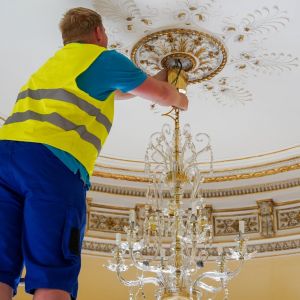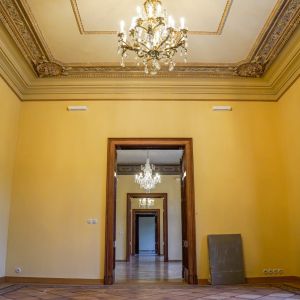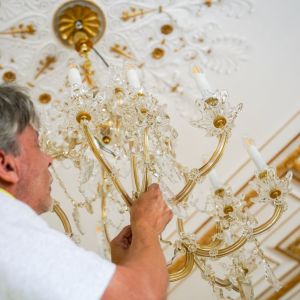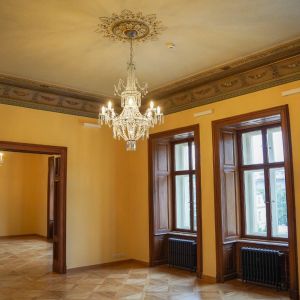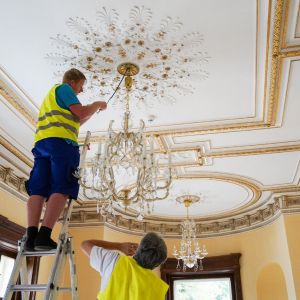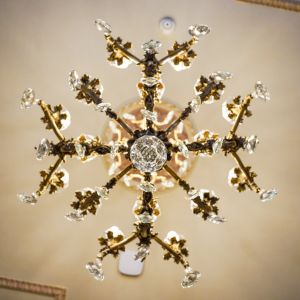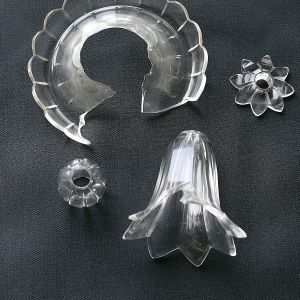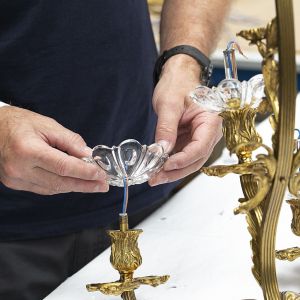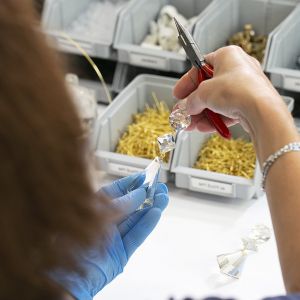Crystal comes to life in the heart of Crystal Valley
23. 9. 2022
Innovative methods, years of proven craft techniques, generations of skill. It’s this tradition and the experience behind it that gives our talented Lightkeepers opportunities to bring the beauty of crystal and light to life in projects close to home and throughout the world.
Historic lighting
Preciosa Lighting, with more than 300 years of glassmaking traditions, participated in the renovation of lighting fixtures for a unique historical palace in Liberec, Czech Republic called Liebieg’s Palace. Original owner Johann Liebieg, Jr. came from a famous family of Liberec textile industrialists. The extensive Neo-Renaissance building built in 1872 featured advanced elements of its time, such as central heating and a garage for the factory owner’s car. In 2022, the listed villa underwent a significant renovation and was transformed into a multifunctional community centre. Twenty crystal chandeliers shine brightly as well.

It is no coincidence that the professional renovation was carried out by the Lightkeepers in Kamenický Šenov; the place where crystal chandelier production in the Bohemia region began. Preciosa Lighting renovation project manager Tomáš Vávra revealed that "most of the lamps (from the palace) are from the second half of the 19th century. It is obvious that they came from Kamenický Šenov because they have typical features for the production of chandeliers from our town. These lamps can even be found in historical catalogues that the company inherited as a remnant of the beginnings of the rich, local glassmaking tradition."
Iconic lighting fixtures
Visitors to Liebieg’s Palace are welcomed with a variety of important historical chandelier models. These include cast crystal chandeliers, the popular Theresian style, and the so-called trimmings baskets. These individual lamps, created more than 100 years ago, combine precise handiwork, a large number of components, diverse materials and production technologies. Also here is one of the most popular historical chandeliers, the Maria Theresa, which shone at the coronation of this important monarch. Crystal lovers can also admire the first all-glass Eugene chandelier, the Rudolph, full of glittering cut crystal, and the revolutionary (for its time) brass-armed Louis chandelier.

Precision and expertise
The extensive renovation included not only basic repairs, but also cleaning and, most importantly, the replacement and addition of the fixtures’ missing parts. Our specialists also undertook the installation itself in the palace. One of the most demanding stages of lighting renovation is the careful labelling of individual parts. Tomáš Vávra explains, “Dismantling a Theresian crystal chandelier, for example, means completely marking all the crystal parts and then putting each one back in its proper place after repairing the finish on the metal arms. The glass slats must be carefully washed and cleaned and must not be confused. It is a complex process for the complete inspection of individual operations, and if you refurbish such a large number of light fixtures at once, you must be constantly on alert and inspect every part of each individual light fixture."
The chandelier restoration was also complex in terms of coordinating all the individual activities. A number of specialized professions worked together, from wooden mould makers, glassblowers, and grinders, to brass part modellers, fitters, technologists, and designers.

Traditional methods on display
The next stage is the actual repair of the damaged or missing parts. Producing completely new parts is always the last option when it comes to renewing lighting fixtures. The project team strives to save each part because they all have incalculable historical value. In addition, glass used in old chandeliers has a different colour than newly produced glass. "If there are ten bowls in the light fixture and one of them needs to be replaced, we have to make it according to the old procedure so that the final effect is exactly the same as with the remaining nine," says Tomáš Vávra. Despite the fact that the "archive" of glass moulds in Kamenický Šenov is very extensive (approx. 7,000 pieces), moulds for damaged glass parts often no longer survive. They therefore have to be remade from wood and any décor used be replicated.

New technologies
The renovated chandeliers are equipped with new electrics. It is necessary to innovate here not only because of currently valid standards, but also because of the impossibility of repairing the original ones. "We completely changed the electrical components on every fixture. The historic wires cracked in our hands during disassembly," says Tomáš Vávra. Thanks to the use of new technologies, the lamps are also much more environmentally friendly. By replacing the old bulbs on all the fixtures with new LED bulbs, significant energy savings will occur.
These 20 historical chandeliers in Liebieg’s Palace, lovingly restored by our Lightkeepers to their original shine and sparkle, create an exceptional collection that represents the most important models of lamps produced in Kamenický Šenov by the predecessors of today’s master glassmakers.
Photos provided by Město Liberec

